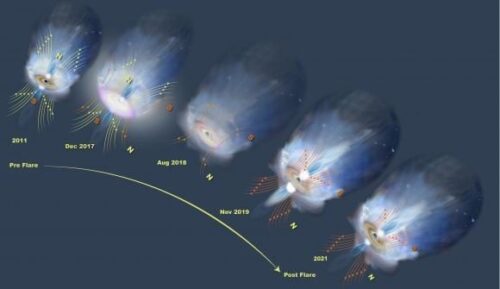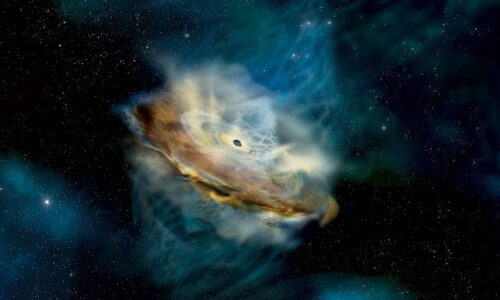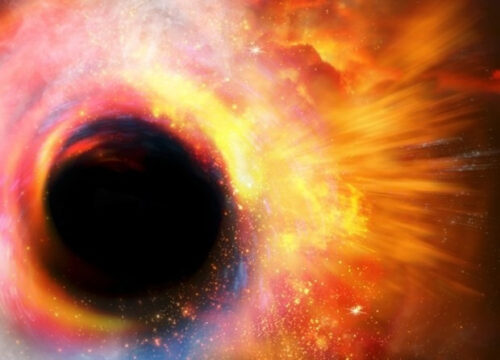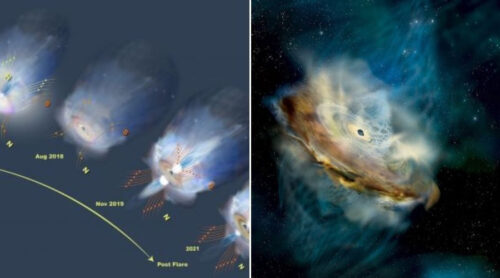
Black holes, known as powerful energy sources in space, play a crucial role in energizing quasars and other active galactic nuclei (AGNs).
The interaction between matter, gravitational forces, and magnetic fields contributes to this phenomenon.
While black holes themselves do not possess a magnetic field, the dense plasma surrounding their accretion discs does.
Recently, scientists made an astonishing revelation when they observed a complete reversal of a black hole’s magnetic field.
This article explores the implications of this discovery and sheds light on the magnetic dynamics within black holes.
The Nature of Magnetic Fields in Black Holes: Although a black hole does not generate its own magnetic field, the charged particles within the surrounding plasma create an electric current, resulting in the formation of a magnetic field.
Generally, the direction of plasma flow remains stable. Thus, the occurrence of a magnetic field reversal, where both the imaginary pole and the magnetic field change direction, is a remarkable event.
Such reversals are relatively common in stars, but until recently, scientists did not anticipate similar phenomena in supermassive black holes.

Unveiling the Magnetic Reversal in a Galactic Black Hole: In 2018, astronomers conducting a sky scan identified a sudden change in a galaxy located 239 million light-years away.
This galaxy, known as 1ES 1927+654, experienced a dramatic increase in brightness, becoming 100 times brighter than its previous state.
Subsequent observations captured by the Swift Observatory revealed the emission of X-rays and ultraviolet light, indicating the occurrence of a cosmic flare.
Previous archival data also showed the galaxy’s gradual brightening, which began towards the end of 2017.
Challenging Existing Theories: Initially, it was speculated that a close encounter between a star and the supermassive black hole at the galaxy’s center caused the sudden brightening.
This scenario, known as a tidal disruption event, occurs when a star approaches the black hole closely, leading to the disruption of the star and the cessation of gas inflow into the black hole’s accretion disc.
However, recent research has cast doubt on this theory, suggesting alternative explanations for the observed phenomena.
The Role of Magnetic Reversals: Careful analysis of cosmic flare data across various wavelengths revealed intriguing patterns.
The researchers noted a rapid decline in the power of X-rays, which are typically generated when charged particles move within strong magnetic fields. This indicated a swift change in the black hole’s magnetic field.

Additionally, visible and ultraviolet light intensities increased, indicating heightened temperatures in certain regions of the accretion disc.
These observations challenged the tidal disruption theory and instead pointed towards a magnetic field reversal as the most plausible explanation.
Understanding Magnetic Field Reversals: When a magnetic reversal occurs within a black hole’s accretion disc, the magnetic fields near the disc’s edges initially weaken. Consequently, the disc heats up more rapidly.
As the magnetic field weakens, fewer X-rays are emitted by charged particles. Once the magnetic field completes its reversal, the disc returns to its previous state. This groundbreaking discovery marks the first observation of a galactic black hole undergoing a magnetic field flip.
Future Research and Implications: While this study provides significant insights into magnetic field dynamics within black holes, the frequency of such reversals and their impact on galaxies remain open questions.
Further research is necessary to determine the frequency with which black holes undergo magnetic field reversals and the potential consequences for galactic structures.

The discovery of a magnetic field reversal in a galactic black hole unveils the incredible dynamics at play within these cosmic phenomena.
This groundbreaking observation challenges previous assumptions and highlights the need for further exploration in understanding the behavior of black holes and their magnetic fields.
By unraveling the mysteries of black hole magnetism, scientists are one step closer to comprehending the intricate workings of our vast universe.
